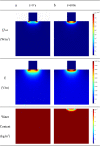Numerical study of the influence of water evaporation on radiofrequency ablation
- PMID: 24325296
- PMCID: PMC3904760
- DOI: 10.1186/1475-925X-12-127
Numerical study of the influence of water evaporation on radiofrequency ablation
Abstract
Background: Radiofrequency ablation is a promising minimal invasive treatment for tumor. However, water loss due to evaporation has been a major issue blocking further RF energy transmission and correspondently eliminating the therapeutic outcome of the treatment.
Method: A 2D symmetric cylindrical mathematical model coupling the transport of the electrical current, heat, and the evaporation process in the tissue, has been developed to simulate the treatment process and investigate the influence of the excessive evaporation of the water on the treatment.
Results: Our results show that the largest specific absorption rate (QSAR) occurs at the edge of the circular surface of the electrode. When excessive evaporation takes place, the water dehydration rate in this region is the highest, and after a certain time, the dehydrated tissue blocks the electrical energy transmission in the radial direction. It is found that there is an interval as long as 65 s between the beginning of the evaporation and the increase of the tissue impedance. The model is further used to investigate whether purposely terminating the treatment for a while allowing diffusion of the liquid water into the evaporated region would help. Results show it has no obvious improvement enlarging the treatment volume. Treatment with the cooled-tip electrode is also studied. It is found that the cooling conditions of the inside agent greatly affect the water loss pattern. When the convection coefficient of the cooling agent increases, excessive evaporation will start from near the central axis of the tissue cylinder instead of the edge of the electrode, and the coagulation volume obviously enlarges before a sudden increase of the impedance. It is also found that a higher convection coefficient will extend the treatment time. Though the sudden increase of the tissue impedance could be delayed by a larger convection coefficient; the rate of the impedance increase is also more dramatic compared to the case with smaller convection coefficient.
Conclusion: The mathematical model simulates the water evaporation and diffusion during radiofrequency ablation and may be used for better clinical design of radiofrequency equipment and treatment protocol planning.
Figures








Similar articles
-
Influence of blood vessel on the thermal lesion formation during radiofrequency ablation for liver tumors.Med Phys. 2013 Jul;40(7):073303. doi: 10.1118/1.4811135. Med Phys. 2013. PMID: 23822457
-
Computer modelling of an impedance-controlled pulsing protocol for RF tumour ablation with a cooled electrode.Int J Hyperthermia. 2016 Dec;32(8):931-939. doi: 10.1080/02656736.2016.1190868. Epub 2016 Jul 24. Int J Hyperthermia. 2016. PMID: 27452352
-
Computational modelling of internally cooled wet (ICW) electrodes for radiofrequency ablation: impact of rehydration, thermal convection and electrical conductivity.Int J Hyperthermia. 2017 Sep;33(6):624-634. doi: 10.1080/02656736.2017.1303751. Epub 2017 Mar 21. Int J Hyperthermia. 2017. PMID: 28540782
-
The biophysics of radiofrequency catheter ablation in the heart: the importance of temperature monitoring.Pacing Clin Electrophysiol. 1993 Mar;16(3 Pt 2):586-91. doi: 10.1111/j.1540-8159.1993.tb01630.x. Pacing Clin Electrophysiol. 1993. PMID: 7681962 Review.
-
A review of radiofrequency ablation: Large target tissue necrosis and mathematical modelling.Phys Med. 2016 Aug;32(8):961-71. doi: 10.1016/j.ejmp.2016.07.092. Epub 2016 Jul 25. Phys Med. 2016. PMID: 27461969 Review.
Cited by
-
Numerical simulation of microwave ablation incorporating tissue contraction based on thermal dose.Phys Med Biol. 2017 Mar 21;62(6):2070-2086. doi: 10.1088/1361-6560/aa5de4. Epub 2017 Feb 2. Phys Med Biol. 2017. PMID: 28151729 Free PMC article.
-
Autofluorescence hyperspectral imaging of radiofrequency ablation lesions in porcine cardiac tissue.J Biophotonics. 2017 Aug;10(8):1008-1017. doi: 10.1002/jbio.201600071. Epub 2016 Aug 22. J Biophotonics. 2017. PMID: 27545317 Free PMC article.
-
Microneedle-Based Delivery: An Overview of Current Applications and Trends.Pharmaceutics. 2020 Jun 19;12(6):569. doi: 10.3390/pharmaceutics12060569. Pharmaceutics. 2020. PMID: 32575392 Free PMC article. Review.
-
Particle swarm optimization solution for roll-off control in radiofrequency ablation of liver tumors: Optimal search for PID controller tuning.PLoS One. 2024 Jun 26;19(6):e0300445. doi: 10.1371/journal.pone.0300445. eCollection 2024. PLoS One. 2024. PMID: 38924000 Free PMC article.
-
A piecewise function of resistivity of liver: determining parameters with finite element analysis of radiofrequency ablation.Med Biol Eng Comput. 2018 Mar;56(3):385-394. doi: 10.1007/s11517-017-1699-6. Epub 2017 Aug 2. Med Biol Eng Comput. 2018. PMID: 28766106
References
-
- Ahmed M, Goldberg S. In: Interventional Oncology. Mueller P, Adam A, editor. New York: Springer; 2012. Principles of radiofrequency ablation; pp. 23–37.
-
- Calderwood SK. In: Tumor Ablation. Volume 5. Keisari Y, editor. Netherlands: Springer; 2013. Hyperthermia, the tumor microenvironment and immunity; pp. 29–37. The Tumor Microenvironment.
Publication types
MeSH terms
Substances
LinkOut - more resources
Full Text Sources
Other Literature Sources

